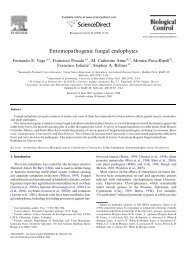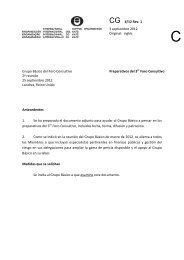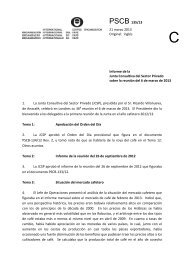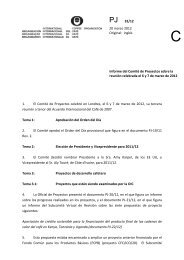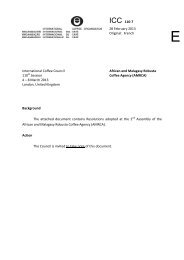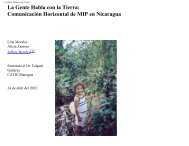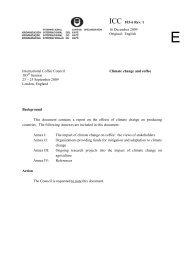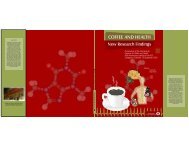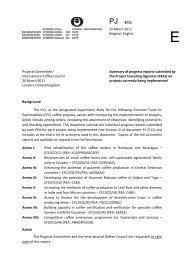Devouring profit - International Coffee Organization
Devouring profit - International Coffee Organization
Devouring profit - International Coffee Organization
Create successful ePaper yourself
Turn your PDF publications into a flip-book with our unique Google optimized e-Paper software.
Picking of the infested berries and treating them with hot water, then burying in<br />
the soil.<br />
Timely and thorough harvest.<br />
Proper gleanings using harvesting picking mats to collect the falling berries.<br />
Drying coffee to the standard test weight.<br />
Early disposal of the crop.<br />
Spraying insecticides in hot spots (in extreme cases only).<br />
The Indian <strong>Coffee</strong> Board has proposed a standard method for CBB sampling at plot<br />
level as a component of the IPM strategy. Farmers are instructed to take 10 plants per<br />
acre at random and then to select 5 branches per coffee tree (50 branches/acre in<br />
total). They establish the infestation level by counting both attacked and non-attacked<br />
berries. This process should be carried out once a month and the decision level for<br />
control is when CBB attacks exceed 5% infestation.<br />
Awareness of the pest a report of the extension campaign on CBB awareness held in<br />
Kogadu district (<strong>Coffee</strong> Board, 2001), covering 130 holdings, reported the following<br />
findings:<br />
All coffee growers were aware of CBB. Personnel from the coffee board had<br />
trained 52% of them, 44% got information through mass media and 4% knew<br />
about the pest from neighbouring farmers.<br />
Knowledge of the pest: 97% of the coffee planters were able to identify the CBB<br />
attack symptoms.<br />
Chemical control: about 11% were acquainted with chemical control measures,<br />
doses, time of spraying, etc. Many of them did not use this measure because of<br />
the low infestation level.<br />
Phytosanitary measures: 65% of coffee growers showed good knowledge of this<br />
control measure.<br />
Biological control: in the survey just one grower was using it. Farmers were quite<br />
sceptical about the utility of bio-pesticides.<br />
Post harvest measures: only 24% were aware of possible control measures during<br />
post harvest processing.<br />
Technology adoption: A socio-economic study carried out by <strong>Coffee</strong> Board and recently<br />
analysed by Duque (2002), showed that the adoption of the components proposed<br />
for CBB management was variable. For instance, components such as gleaning<br />
collections and the use of picking mats were the most adopted. However the fungus<br />
B. bassiana was poorly adopted by the farmers as was the use of sticky traps. Table 13<br />
summarizes the adoption of all the components of the IPM strategy for controlling<br />
CBB in India.<br />
33




